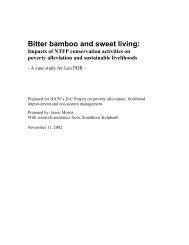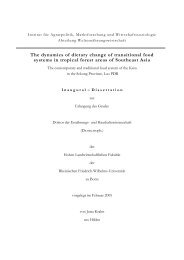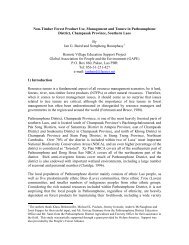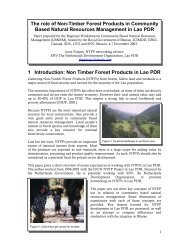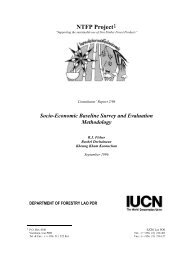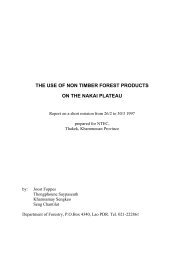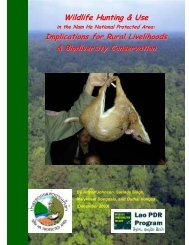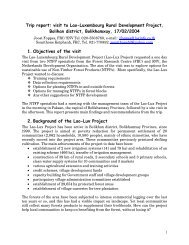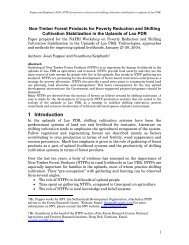Create successful ePaper yourself
Turn your PDF publications into a flip-book with our unique Google optimized e-Paper software.
LAO PDR<br />
Supply Capacity Survey<br />
on medicinal herbs<br />
20/12/04-19/01/05<br />
Survey prepared by Sengphet Phongphachanh<br />
National Consultant
Acknowledgement<br />
The supply capacity survey on medicinal plants was made possible by the<br />
contributions of ITC/UNTACD/WTO, numerous individuals, governmental<br />
ministries, departments, institutions, public and private businesses. Without the<br />
efforts and support of the committed individuals, organizations and businesses<br />
mentioned above, the author would not have been able to undertake this survey. All<br />
the contributors are gratefully acknowledged for their support of this report.
I. Introduction<br />
TABLE OF CONTENTS<br />
A. <strong>Medicinal</strong> plants covered under this survey<br />
B. Significant of medicinal plants to the economy<br />
C. Specific objective of the survey<br />
D. Methodology<br />
II. Structure of the medicinal plants sector<br />
A. Production and Capacity<br />
B. Prices<br />
C. Shipping<br />
D. Packaging<br />
E. Quality Control<br />
F. Local Market<br />
G. Export<br />
H. CITES Constraints<br />
I. Company’ Needs Assessment<br />
III. Conclusion and Recommendations<br />
IV. Limitation to the development of medicinal plant sector in <strong>Lao</strong><br />
PDR<br />
V. Limitation<br />
VI. Annexes
I. INTRODUCTION<br />
<strong>Lao</strong> PDR possesses a wealth in medicinal plants which can provide a<br />
potential for <strong>Lao</strong> PDR to export. Currently, export of medicinal plants is<br />
becoming an attracting business opportunity for exporters and potential<br />
exporters in <strong>Lao</strong> PDR to tap in the medicinal plants sector. The reason for this<br />
is that firstly the world population is more interested in natural products and<br />
thus the consumption of herbal medicines is gaining its momentum recently;<br />
and secondly, according to the World Health Organization (WHO) estimation,<br />
the demand for medicinal plants is about US $14 billion a year and projected<br />
by the year 2050 is US$5 trillion.<br />
However to enter in this competitive world market , it is important for<br />
the exporters and potential exporters to have a realistic and relevant strategy to<br />
ensure a sustainable export growth and this is the reason of International<br />
Trade Center (ITC) in collaboration with <strong>Lao</strong> National Trade Promotion<br />
Center has established a Trade Promotion Project in medicinal plants sector.<br />
A starting point of this project is to conduct a survey to identify the<br />
supply capacity of medicinal plants. Thus, this report described issues and<br />
considerations regarding supply capacity of medicinal plants and this will then<br />
provide an initiative for a further development of marketing plan for export of<br />
medicinal plants in <strong>Lao</strong> PDR. The end output of this project is a sellers and<br />
buyers’ meeting.<br />
A. <strong>Medicinal</strong> plants covered under the survey<br />
<strong>Medicinal</strong> plants covered under the survey are the medicinal plants<br />
which have been already exported (Table 1) and the medicinal pants which<br />
have potential for exportation (Table 2).
Table 1: <strong>Medicinal</strong> plants that have been already exported:<br />
No Tariff Local Group Scientific<br />
Code Name<br />
Name<br />
1 1211.90.95 Nha<br />
Orthosiphon<br />
Nouad<br />
stamineus<br />
Meo<br />
Benth<br />
2 1301.90.10 Nhane III Styrax<br />
tonkinense P.<br />
3 1302.12.00 Kheua II Coscinium<br />
Hem<br />
usitatum Pierre<br />
4 0908.30.00 Mak<br />
Neng<br />
5 1211.90.99 Khing<br />
dam<br />
6 1211.90.94 Chan dai<br />
deng<br />
II Amomum<br />
ovoideum P.<br />
III<br />
Kaempferia<br />
parviflora<br />
Wall.<br />
Dracaena<br />
cambodiana<br />
Pierre ex<br />
Gagnep<br />
7 1211.90.94 Khe Hom II Cinnamomum<br />
cassia Presi<br />
8 083.50.00<br />
Chong<br />
Ban<br />
9 1211.90.95 Phak<br />
Nok Na<br />
10 1211.90.95 Seng<br />
Beua<br />
III<br />
Sterculia<br />
lychnophora<br />
HANCE<br />
Centella<br />
asiatica<br />
Urban<br />
III Strychnos nux<br />
vomica L.<br />
Used<br />
Parts<br />
Aerial<br />
part<br />
Indication Sources<br />
Diuretic and<br />
Rheumatism<br />
Whole country<br />
Resin Expectorants Northern part<br />
Liana Diabetes<br />
mellitus,<br />
Hepatitis and<br />
Dysentery<br />
Seed Stomach ache<br />
And nervine<br />
tonic<br />
Rhizome Ulcer gastric<br />
and Tonic<br />
Red<br />
lignified<br />
core<br />
Tree bark<br />
& Stem<br />
bark<br />
Bruises,<br />
Contusions and<br />
inflammation<br />
Dyspepsia,<br />
Diarrhea and<br />
colic<br />
Fruit Dysentery and<br />
inflammation<br />
Whole<br />
plant<br />
Seeds of<br />
ripe fruit<br />
Table2: <strong>Medicinal</strong> plants which have a potential for exportation<br />
Tonic, Fever<br />
and<br />
Constipation<br />
Neuralgia<br />
Paralysis<br />
Myasthenia<br />
Attapeu,<br />
khammoun,<br />
and Vientiane<br />
Province<br />
Northern part<br />
Northern part<br />
Northern part<br />
(Mountainous<br />
areas)<br />
Northern part<br />
(Mountainous<br />
areas)<br />
Champasak,Sal<br />
avanh, Xekong,<br />
Attapeu<br />
Whole country<br />
Southern part<br />
No. Tariff Local Group Scientific Name Used Indication Sources<br />
Code Name<br />
parts<br />
1 1211.90.99 Tin Pet III Alstonia scholaris Bark Anemia, Whole country<br />
(L.)<br />
Colic and<br />
acute arthritis<br />
2 1211.90.99 Ya Hua III Smilax glabra Rhizome Rheumatism, Northern part<br />
Roxb.<br />
appetite (Samnua,<br />
stimulants Xieng khuang,<br />
and nervine Luangprabang)
3 1211.90.99 Seng<br />
Kham<br />
Ton<br />
4 1211.90.99 Khing<br />
Kheng Pa<br />
Kang<br />
5 1211.90.99 Hua ka<br />
bouk<br />
6 1211.90.99 Ki Min<br />
Kheun<br />
7 1211.90.99 Mak<br />
Toum<br />
8 1211.90.99 Tom<br />
Ngeun<br />
9 1211.10.90 Oy Sam<br />
Suan<br />
10 1211.10.90 Van<br />
Nang<br />
11 1211.90.99 Chi nai<br />
kom<br />
12 1211.90.99 Phak<br />
boua<br />
leuad<br />
13 1211.90.99 Mak Yo<br />
Pa<br />
14 1211.90.99 Kua Phak<br />
Buang<br />
15 1211.90.99 Kav<br />
Keua<br />
deng<br />
16 1211.90.99 Kua<br />
II Terminalia<br />
nigrovenulosa L.<br />
III Homalomena<br />
aromatica Schott<br />
Amorphophalus<br />
campanulatus<br />
BL.<br />
Curcuma<br />
domestica Valet<br />
III Aegle marmelos<br />
III<br />
Corr.<br />
Stephania<br />
rotunda Lour<br />
III Streptocaulon<br />
extensum Wight<br />
III<br />
II<br />
Curcuma<br />
xanthorizae<br />
Adenosma<br />
indianum<br />
Eleutherine<br />
subaphylla<br />
Gagnep.<br />
Morinda<br />
Tinctoria Roxb.<br />
Passiflora foetida<br />
L.<br />
tonic<br />
Stem Dysentery<br />
hematic tonic<br />
Rootstocks<br />
Stomachic<br />
remedy,<br />
Hepatitis and<br />
Rheumatism<br />
Whole country<br />
Northern part<br />
Rhizome Malaria Northern part<br />
Rhizome Gastric ulcer<br />
and Hepatitis<br />
Fruit Appetite<br />
stimulants<br />
Tuberous Sedative and<br />
roots cardiac tonic<br />
Liana Sore throat<br />
and gastric<br />
ulcer<br />
Rhizome Vaginodynia<br />
&<br />
genitourinary<br />
tract<br />
Aerial<br />
part<br />
Infections<br />
Antibacterial<br />
and<br />
Cholagogic<br />
Bulbs Anemia,<br />
Inflammation<br />
and gastric<br />
ulcer<br />
Fruit Hypertension<br />
Diabetic<br />
Aerial<br />
parts<br />
Butea superba Tuberous<br />
roots<br />
III Tinospora crispa<br />
Koua Ho<br />
(L.)<br />
17 1211.90.99 Rasabi Andrographis<br />
paniculata<br />
(Burm.f.) Nees.<br />
Insomnia<br />
Neurasthenia<br />
Male tonic,<br />
Rheumatism<br />
Stem Tonic,<br />
Fever<br />
Aerial Bronchitis,<br />
parts Bacillary<br />
dysentery<br />
and Diarrhea<br />
Whole country<br />
Whole country<br />
Northern part<br />
Middle part<br />
(Salakam)<br />
Whole country<br />
Whole country<br />
Whole country<br />
Northern part<br />
Whole country<br />
Whole country<br />
Whole country<br />
Whole country
18 1211.90.99 Mone Morus acidosa<br />
Griff<br />
19 1211.90.99 Mak<br />
Kham<br />
pom<br />
Phyllanthus<br />
emblica Linn.<br />
20 1211.90.99 Kav Bok Catharanthus<br />
roseus (L.)<br />
Leaves Hypertension<br />
Insomnia<br />
Cough<br />
Fruits Hypertension<br />
Expectorants<br />
Aerial<br />
parts<br />
Cardiac<br />
Remedy,<br />
Hypertension<br />
Whole country<br />
Whole country<br />
Whole country<br />
21 1211.90.99 Nat hom<br />
Artemisia annua Leaves Malaria Whole country<br />
Ban Noy<br />
L.<br />
22 1211.90.99 Bi Khon III Brucea sumatrana Whole Diabetic Southern part<br />
Roxb.<br />
plants<br />
23 1211.90.99 Man Kha III Codonopsis Tuberous Tonic, Xieng Kuang<br />
Kai<br />
javanica (Blume) roots Anorexia and<br />
Hook.f.<br />
Anaemia<br />
24 1211.90.99 Man On III Polygonum Tuberous Neurasthenia, Sam Nua<br />
ling<br />
multiflorum roots Anemia and<br />
Thunb.<br />
Arthritis<br />
25 1211.90.99 Mak<br />
Coix lacryma- Fruits Diuretic and Whole country<br />
Deuy<br />
heen<br />
jobi L.<br />
General tonic<br />
26 1211.90.99<br />
Iene<br />
don<br />
II Osbeckia<br />
Chinensis L.<br />
roots Diabetic<br />
mellitus,<br />
Malaria and<br />
Appetite<br />
stimulans<br />
The tariff codes used for medicinal plants in this survey are in the<br />
ASEAN Harmonized Tariff Nomenclature (AHTN). The AHTN is based<br />
on H.S 2002 under the World Customs Organization (WCO). The AHTN<br />
comprises of three-category digit code: Heading No with 4-digit code,<br />
Subheading No with 6 and 8 digit code. The tariff code 1211.90.99 is<br />
used for the general terms “Other” of medicinal plants and medicinal<br />
plants parts. Since the medicinal plants are not only used as raw materials<br />
for traditional medicines but they can also be used as materials for<br />
pharmaceutical products, foods, cosmetics, perfumery, thus their tariff<br />
codes are binding to different Heading Nos.<br />
According to the National Decree endorsed by the Prime Minister<br />
regarding medicinal natural resources in September 2003, medicinal plants<br />
Middle to<br />
Southern part
are categorized in three groups. Group I includes rare and endangered<br />
medicinal plants while Group II are medicinal plants which have<br />
commercial values. The last group, Group III includes medicinal plants<br />
which are abundant. For Group I medicinal plants, the exploitation and<br />
harvesting have to be certified from the Ministry of Health and concerned<br />
authorities. In terms of Group II medicinal plants, the exploitation and<br />
harvesting have to be certified from the Ministry of Health and concerned<br />
authorities by providing a management plan about harvesting and<br />
reforestation. In this report, there are five medicinal plants from group II<br />
such as, Coscinium usitatum Pierre, Amomum ovoideum P.,<br />
Cinnamomum cassia Presi, Terminalia nigrovenulosa Pierre, Morinda<br />
Tinctoria Roxb and Osbeckia Chinensis L.<br />
B. Significant of medicinal plants to the economy<br />
In rural area of <strong>Lao</strong> PDR, most people depend on the use of<br />
medicinal plants in preventing and curing diseases. Therefore, they collect<br />
medicinal plants from the wild to serve this purpose. In addition, for the<br />
medicinal plants which have commercial values, they also try to cultivate<br />
in order to supply to the market. However, medicinal plants sector is not<br />
well developed as this sector has received low priority in national<br />
investment, research and export development.<br />
Even though, <strong>Lao</strong> PDR is an agricultural based economy and<br />
possesses its capability in supplying of medicinal plants for the world<br />
market, this potential is not well managed to become a national<br />
competitive advantage if compare with other neighboring countries such<br />
as Thailand and Vietnam. If in <strong>Lao</strong> PDR, this medicinal plants sector is<br />
well managed and promoted, it can have a remarkable contribution to the<br />
sustainable export performance and lead to the economic growth of the<br />
country. This sector can generate income to the people in rural area
especially create a job opportunity, and reduce poverty. Moreover, the<br />
successful development of this sector will contribute positive impacts for<br />
the development of the national health care systems, improvement of<br />
people welfare, creation of competitive pharmaceutical products, and<br />
encouragement of new effective and less side effect drug discovery in the<br />
pharmaceutical industry. Furthermore, medicinal plants are not only used<br />
as raw materials in the pharmaceutical industry, they can also be used as<br />
raw materials in the food, cosmetic and perfumery industry.<br />
C. Specific objectives of the survey<br />
The objective of the survey is to describe the current situation in<br />
the sector of medicinal plants. The survey provides the information on the<br />
supply capacity of medicinal plants in <strong>Lao</strong> PDR. The supply survey aims<br />
at:<br />
• Describing the characteristics and structure of the sector<br />
• Identifying obstacles that impede the export capabilities<br />
• Assessing the potential for increasing supply capacity and for new<br />
investment opportunities<br />
• Determining specific technical support requirements<br />
D. Methodology<br />
The survey consisted of two steps: desk survey and field survey.<br />
Desk survey was conducted through various departments and<br />
institutions in Vientiane such as, Department of Food and Drugs,<br />
Traditional Medicine Research Center, Forestry Conservation Agency,<br />
Department of Customs, Department of transportation, Department of<br />
Foreign Trade. In addition, Trade Departments and Traditional Medicine<br />
Stations at provincial level were contacted by phone and fax for a desk<br />
survey.
Field research included interviews with experts in the medicinal<br />
plants field and representatives from public and private pharmaceutical<br />
and agriculture companies, altogether 11 companies. Of these,<br />
questionnaires were distributed to eight companies in order to assess their<br />
needs and impediments related to exports. These eight companies were<br />
Pharmaceutical Factory No.2, Pharmaceutical Factory No.3, Vienthong<br />
Trading Company LTD., Kaphayanak <strong>Lao</strong> Herbal <strong>Medicinal</strong> Factory,<br />
Kanoukham <strong>Lao</strong> herbal medicinal Factory, Society Development of Forest<br />
Export-Import Luangprabang, CBF Pharmacy Co. ltd. and Agroforex<br />
Company. In addition, a site visit was conducted at DanKham village in<br />
Vientiane where Orthosiphon stamineus Benth is cultivated. Agroforex is<br />
the company which cultivates Orthosiphon stamineus Benth for export.<br />
It should be noted that some figures (capacity supply, local price)<br />
provided in this report were based on estimation due to the absence of<br />
alternative sources of statistics.<br />
II. STRUCTURE OF THE MEDICINAL PLANTS SECTOR<br />
<strong>Medicinal</strong> plants sector in <strong>Lao</strong> PDR are currently in its infancy<br />
development. Even though, <strong>Lao</strong> PDR possesses high potential in medicinal<br />
plants, which can be used for herbal remedies and herbal supplements,<br />
medicinal plants are not widely used in <strong>Lao</strong> PDR and also have low local<br />
market share as compared to modern medicines. This is because of a lack of<br />
scientific knowledge of herbal medicines which leads to the low priority in<br />
usage of herbal medicines by consumers especially modern doctors.<br />
A. Production and Capacity<br />
The supply base of medicinal plant products is largely from the<br />
wild sources and this wild source. However a quota is needed from the<br />
Department of Forestry and agriculture for commercial collection of wild
medicinal plants. Quotas of some medicinal plants for the year 2004 to<br />
2005 are provided in Annex 1.<br />
Currently, reforestation of medicinal plants is not widely<br />
implemented and as a result of this, this wild source is shrinking from time<br />
to time. Therefore, there is a need for cultivation of medicinal plants as<br />
cultivation will provide a sustainable alternative to the present collection<br />
from the wild and also a sustainable supply of medicinal plant products to<br />
the export market. However, to make cultivation of medicinal plants,<br />
resources are needed such as land, manpower, money, etc. Thus, access to<br />
regular and consistent market demand and access to financial sources are<br />
important and necessary for the investment in cultivation of medicinal<br />
plants.<br />
Table 3 shows medicinal plants, which have been already<br />
exported; and Table 4 lists medicinal plants which have a potential for<br />
exportation. The figures given in the tables are made on estimation based<br />
on the information of the Forestry Research Center, Export Companies,<br />
Potential Export Companies, herbalists, collectors and cultivators.<br />
Table 3: <strong>Medicinal</strong> plants that have been already exported:<br />
No. Scientific<br />
Name<br />
1 Orthosiphon<br />
stamineus<br />
Benth<br />
2 Styrax<br />
tonkinense P.<br />
3 Coscinium<br />
usitatum Pierre<br />
4 Amomum<br />
ovoideum P.<br />
Product Supply<br />
Capacity<br />
Dried aerial<br />
part<br />
Tones/year<br />
100<br />
Collection<br />
Types<br />
References<br />
cultivate Cultivator<br />
Dried resin 120-150 wild Society Development<br />
of Forest Export-<br />
Import LuangPrabang<br />
& Viengthong<br />
Trading Co. Ltd.<br />
Dried liana 50 wild Herbal Trading<br />
Import-Export Co.<br />
Ltd.<br />
Dried seed 1000-1800 wild Society Development<br />
of Forest Export-
5 Kaempferia<br />
parviflora Wall.<br />
6 Dracaena<br />
cambodiana<br />
Pierre ex<br />
Gagnep<br />
7 Cinnamomum<br />
cassia Presi<br />
8 Sterculia<br />
lychnophora<br />
HANCE<br />
9 Centella asiatica<br />
Urban<br />
10 Strychnos nux<br />
vomica L.<br />
Dried<br />
rhizome<br />
Dried red<br />
lignified<br />
core<br />
Dried tree<br />
and stem<br />
bark<br />
Dried fruit 1000<br />
(every 4<br />
years<br />
period)<br />
Dried<br />
whole plant<br />
Import LuangPrabang<br />
& Viengthong<br />
Trading Co. Ltd.<br />
30-40 cultivate Society Development<br />
of Forest Export-<br />
Import LuangPrabang<br />
150 wild Viengthong Trading<br />
Co. Ltd. & Forestry<br />
Research Center<br />
500 wild Viengthong Trading<br />
Co. Ltd.<br />
wild Forestry Research<br />
Center<br />
10 wild collectors<br />
Dried seed 5 wild collectors<br />
Table2: Medecinal plants which have a potential for exportation:<br />
No. Scientific<br />
Name<br />
1 Alstonia<br />
scholaris L.<br />
2 Smilax glabra<br />
Roxb.<br />
3 Terminalia<br />
nigrovenulosa<br />
L.<br />
4 Homalonema<br />
occulta (Lour.)<br />
Schott<br />
5 Amorphophalus<br />
campanulatus<br />
BL.<br />
6 Curcuma<br />
domestica Valet<br />
7 Aegle marmelas<br />
Corr.<br />
Product Supply<br />
Capacity<br />
Tones/year<br />
Collection<br />
Types<br />
References<br />
Dried Bark 12-15 Wild Forestry Research<br />
Center<br />
Dried<br />
rhizome<br />
20 Wild Collector<br />
Dried Stem 50 Wild Collector<br />
Dried root<br />
stocks<br />
Dried<br />
rhizome<br />
30 Wild Collector<br />
50 Wild Collector<br />
Dried 100 Cultivate Pharmaceutical<br />
rhizome<br />
Factory No. 2<br />
Dried fruit 20 Wild /<br />
Cultivate<br />
Collector
8 Stephania<br />
rotunda Lour<br />
9 Streptocaulon<br />
extensum Wight<br />
10 Curcuma<br />
xanthorizae<br />
11 Adenosma<br />
indianum<br />
12 Eleutherine<br />
subaphylla<br />
Gagnep.<br />
13 Morinda<br />
Tinctoria Roxb.<br />
14 Passiflora<br />
foetida L.<br />
15 Butea superba<br />
16 Tinospora<br />
crispa (L.)<br />
17 Andrographis<br />
paniculata<br />
(Burm.f.) Nees.<br />
18 Morus acidosa<br />
Griff.<br />
19 Phyllanthus<br />
emblica Linn.<br />
20 Catharanthus<br />
roseus (L.)<br />
21 Artemisia Annua<br />
L.<br />
22 Brucea<br />
sumatrana<br />
Roxb.<br />
23 Codonopsis<br />
javanica<br />
(Blume)<br />
Hook.f.<br />
24 Polygonum<br />
multiflorum<br />
Thunb.<br />
25 Coix lacrymajobi<br />
L.<br />
Dried<br />
tuberous<br />
root<br />
50 Wild Collector<br />
Dried Liana 50 Wild Collector<br />
Dried 50 Wild / Pharmaceutical<br />
rhizome<br />
Cultivate Factory No. 2<br />
Dried aerial 30 Wild Pharmaceutical<br />
part<br />
Factory No. 2<br />
Dried bulb 50 Cultivate Collector<br />
Dried fruit 20 Wild Collector<br />
Dried aerial 100 Wild/ Pharmaceutical<br />
part<br />
Cultivate Factory No.3<br />
Dried<br />
tuberous<br />
root<br />
100 Wild Collector<br />
Dried stem 100 Wild Collector<br />
Dried aerial<br />
part<br />
10 Cultivate Collector<br />
Dried leaves 50 Wild /<br />
Cultivate<br />
Collector<br />
Dried fruits 10 Wild Collector<br />
Dried aerial 100 Wild/ Pharmaceutical<br />
part<br />
Cultivate Factory No. 3<br />
Dried leaves 350 Cultivate CBF Pharmacy Co.<br />
ltd.<br />
Dried 10 Cultivate Kaphayanak <strong>Lao</strong><br />
whole plant<br />
Herbal <strong>Medicinal</strong><br />
Factory<br />
Dried 40-50 wild Herbal Trading<br />
tuberous<br />
Import-Export Co.<br />
roots<br />
Ltd.<br />
Dried<br />
tuberous<br />
part<br />
20 wild Herbal Trading<br />
Import-Export Co.<br />
Ltd.<br />
Dried fruit 100 wild Collectors
26 Osbeckia<br />
Chinensis L.<br />
Dried roots 20 wild Collectors<br />
The main problems of medicine plants production and capacity are as follows:<br />
• Lack of financing support in cultivation of medicinal plants<br />
• Difficulty in estimation of the supply capacity on dried medicinal<br />
plants as most of medicinal plants are collected from wild sources<br />
• Difficulty in identification of accurate species of medicinal plants in<br />
collecting and harvesting as many species exist<br />
• Poor agricultural practices and lack of knowledge on proper time and<br />
methods for plant identification, collection/harvesting, storage and<br />
post-harvest treatment practices<br />
• Lack of quality control and application of appropriate standards and<br />
good processing practices and this can lead to low and inconsistent of<br />
quality of dried medicinal plants<br />
• Insufficient sunshine for drying of medicinal plants during rainy<br />
season<br />
• Labor intensive and use of simple technology<br />
• Lack of R&D of high-yielding medicinal plant species<br />
• Difficulty in collecting and harvesting of wild medicinal plants in<br />
mountainous areas<br />
• Most medicinal plants are collected from wild sources and this can<br />
lead to the extinction of some endangered species due to improper<br />
harvesting practices. These improper harvesting practices may create<br />
dangerous consequences for the preservation of medicinal plants and<br />
might only produce short-term benefit and lead to the diminishing<br />
comparative advantage of the country’s natural resources, which will<br />
be very difficult to regain in the future.
B. Prices<br />
Table 5 shows a local price of exported medicinal plant products.<br />
Table 6 shows a local price for potential exported medicinal plant<br />
products. The prices shown in Table 5 and 6 are given as minimum and<br />
maximum figures. These figures are based on the estimation of various<br />
sources such as, Provincial Traditional Medicine Stations (Xieng Khuang,<br />
Oudomxay, Xayabouli, Luangprabang, Savannakhet, Champasak and<br />
Vientiane), companies, herbalists and collectors. Pricing terms can be<br />
affected by many factors such as seasonality, collection type, prevalence,<br />
collection distance and illegal trade. The prices shown in Table 5 and 6<br />
don’t include shipping costs.<br />
Table 5: Local price of medicinal plant products which have been already<br />
exported:<br />
No. Scientific Name Product Minimum local<br />
Price<br />
(Kip/kg dry)<br />
1 Orthosiphon Dried aerial 15.000<br />
stamineus Benth part<br />
2 Styrax tonkinense<br />
P.<br />
3 Coscinium usitatum<br />
Pierre<br />
4 Amomum<br />
ovoideum P.<br />
5 Kaempferia<br />
parviflora Wall.<br />
6 Dracaena<br />
cambodiana Pierre<br />
ex Gagnep<br />
7 Cinnamomum<br />
cassia Presi<br />
8 Sterculia lychnophora<br />
HANCE<br />
9 Centella asiatica<br />
Urban<br />
10 Strychnos nux<br />
vomica L.<br />
Dried resin 15.000 30.000<br />
Dried liana 6.000 28.000<br />
Dried seed 15.000 50.000<br />
Dried rhizome 60.000 150.000<br />
Dried red<br />
lignified core<br />
15.000 25.000<br />
Dried tree and<br />
stem bark<br />
5000 25.000<br />
Dried fruit 25.000 50.000<br />
Dried part of<br />
whole plant<br />
10.000 50.000<br />
Dried seed Na Na<br />
Maximum local<br />
Price<br />
(Kip/kg dry)<br />
50.000
Table 6: Local price of medecinal plants products which have a potential for<br />
exportation<br />
No. Scientific Name Product Minimum local<br />
Price<br />
(Kip/kg dry)<br />
1 Alstonia scholaris<br />
L.<br />
2 Smilax glabra<br />
Roxb.<br />
3 Terminalia<br />
nigrovenulosa L.<br />
4 Homalonema<br />
occulta (Lour.)<br />
Schott<br />
5 Amorphophalus<br />
campanulatus BL.<br />
6 Curcuma domestica<br />
Valet<br />
7 Aegle marmelas<br />
Corr.<br />
8 Stephania rotunda<br />
Lour<br />
Dried Bark 4.000 15.000<br />
Dried rhizome 5.000 35.000<br />
Dried Stem 4.000 10.000<br />
Dried root<br />
stocks<br />
5.000 25.000<br />
Dried rhizome 5.000 25.000<br />
Dried rhizome 7.000 25.000<br />
Dried fruit 10.000 30.000<br />
Dried<br />
tuberous root<br />
10.000 45.000<br />
Maximum local<br />
Price<br />
(Kip/kg dry)<br />
9 Streptocaulon<br />
extensum Wight<br />
Dried Liana 20.000 30.000<br />
10 Curcuma<br />
xanthorizae<br />
Dried rhizome 20.000 100.000<br />
11 Adenosma Dried aerial 5.000 10.000<br />
indianum<br />
part<br />
12 Eleutherine<br />
subaphylla Gagnep.<br />
Dried bulb 20.000 100.000<br />
13 Morinda Tinctoria<br />
Roxb.<br />
Dried fruit 15.000 30.000<br />
14 Passiflora foetida L. Dried aerial<br />
part<br />
10.000 30.000<br />
15 Butea superba Dried<br />
tuberous root<br />
Na Na<br />
16 Tinospora crispa<br />
(L.)<br />
Dried stem 15.000 50.000<br />
17 Andrographis Dried aerial 30.000 70.000<br />
paniculata<br />
(Burm.f.) Nees.<br />
part
18 Morus acidosa<br />
Griff.<br />
Dried leaves 10.000 30.000<br />
19 Phyllanthus emblica<br />
Linn.<br />
Dried fruits 15.000 25.000<br />
20 Catharanthus roseus Dried aerial 10.000 50.000<br />
(L.)<br />
part<br />
21 Artemisia Annua L. Dried leaves Na Na<br />
22 Brucea sumatrana Dried part of 20.000 30.000<br />
Roxb.<br />
whole plant<br />
23 Codonopsis Dried 8.000 20.000<br />
javanica (Blume)<br />
Hook.f.<br />
tuberous roots<br />
24 Polygonum Dried 8.000 20.000<br />
multiflorum Thunb. tuberous roots<br />
25 Coix lacryma-jobi<br />
L.<br />
Dried fruit 5.000 15.000<br />
Osbeckia Chinensis Dried roots 40.000 50.000<br />
26 L.<br />
Note: Na: Not available<br />
C. Shipping<br />
Transportation of goods in <strong>Lao</strong> PDR is mainly depends on road<br />
route. The government has currently upgraded and improved the road<br />
system in order to ensure smooth traffic throughout the country. This<br />
improvement of road system will facilitate the transportation of exported<br />
goods.<br />
In <strong>Lao</strong> PDR, there are 19 transportation companies, 17 packaging<br />
and shipping companies and 10 associations of goods’ transportation<br />
which provides international services.<br />
In order to enhance the facilitation on international road<br />
transportation, <strong>Lao</strong> government has signed the agreements on road<br />
transportation with Vietnam, Thailand, China and Cambodia; the<br />
government is currently in the process of preparing to sign agreements on<br />
road transportation with other ASEAN member countries and is expected<br />
to complete in 2005.
However, the transportation cost is high due to the new regulation<br />
of reducing truck load volume for goods’ transportation.<br />
In terms of customs services, all of the goods exported should have<br />
their products match with the tariff codes established by the department of<br />
Customs. There are no duties on export of medicinal plant products only<br />
fees for the processing of documents.<br />
D. Packaging<br />
However, special fee have to be paid for export of wild products.<br />
In terms of crude medicinal plants packaged in bulk form,<br />
packaging should be design to protect from moisture as it can have<br />
negative impact on the quality of medicinal plants. Packaging materials<br />
used are mainly P.E. plastic bags, jute bags, wooden boxes, drums and<br />
paper cartons. Some packaging materials are imported from Thailand and<br />
Vietnam.<br />
E. Quality control<br />
The quality control of crude medicinal plants is not very strict compared to<br />
semi-products or finished products of medicinal herbs. However, <strong>Lao</strong><br />
PDR still face with some constraints in terms of quality control mainly:<br />
• Lack of skilled and qualified human resources in identify<br />
medicinal plants species and quality control of medicinal plant<br />
products<br />
• Lack of facilities and equipments to control and sustain quality of<br />
medicinal plants<br />
• Lack of reference documents such as pharmacopeias for<br />
medicinal plants
• Poor quality control procedures and lack of standardization in<br />
processing procedures and methods of medicinal plants which<br />
can lead to low and inconsistent quality<br />
The Food and Drug Department, Ministry of Health, has recently<br />
established a new division called Division of Traditional Medicines. This<br />
division is currently in the process of developing and establishing policies<br />
and regulations regarding the administration of traditional medicines from<br />
raw materials to the finished products and these are expected to be<br />
completed sometime in 2005.<br />
F. Local market<br />
<strong>Medicinal</strong> plants are used throughout the country but still not<br />
popular if compared with western medicines. Therefore, the local market<br />
of medicinal plant products is small in size and most household base.<br />
Most consumption of medicinal plant products is found in remote areas.<br />
This is due to first people living in remote areas still have limited access to<br />
health care facilities such as hospitals and clinics; and second western<br />
medicines are costly for them if compared with their income; and thus<br />
they could not afford to buy those expensive western medicines.<br />
Herbal medicines supplying to the local market are in different<br />
forms ranked from unprocessed forms such as crude medicinal plants to<br />
processed forms such as extracts, liquor, tea, syrups and tablets. These<br />
herbal medicines are supplied from different sources such as<br />
pharmaceutical companies, herbal medicine factories and retail herbal<br />
medicine shops mostly owned by healers and herbalist.<br />
G. Export<br />
Export system of medicinal plant products exists currently both<br />
official and non-official. Currently, medicinal plants are exported in small
quantities. Export markets of <strong>Medicinal</strong> plant products are Thailand,<br />
China, Germany, France, South Korea, Europe, Middle E. and S.E. Asia<br />
and New York.<br />
Annex 2 lists three medicinal herb manufacturing companies.<br />
Annex 3 and 4 show three export companies and five potential<br />
export company profiles. Also, detailed company profile and product<br />
profile of these export companies and potential export companies are<br />
provided in Annex 5.<br />
In terms of export of medicinal plants, the main constrains are<br />
mainly:<br />
• Lack of national standards of medicinal plants products<br />
• Lack of market demand<br />
• Lack of trade contracts<br />
• Existing of unorganized and informal cross-border trade<br />
• Lack of export incentives from governmental organization<br />
• Lengthy and complicated export procedures<br />
• Not clearly defined policy and lack of coordination among<br />
authorities for medicinal plants sector concerning export<br />
registration and commercialization<br />
• Lack of market information regarding exports in terms of<br />
quality, quantity and price, information about the world trade and<br />
demand dynamics in the overseas market<br />
• Lack of knowledge on international and specific regulations of<br />
importing countries governing imports of medicinal plants<br />
including quality, Intellectual Property Rights etc.<br />
• High transportation cost due to current regulation of reducing<br />
truck load volume for goods’ transportation<br />
And the main incentives are mainly:<br />
• Export duties’ exemption
• Increasing market demand for herbal medicines worldwide<br />
• The abundant supply of medicinal plants and the supportive<br />
climate for sustainable cultivation and exploitation<br />
• The availability of land for cultivation of medicinal plants<br />
H. Constraints regarding CITES<br />
CITES (Convention on International Trade in Endangered Species<br />
came into force on July 1, 1975. <strong>Lao</strong> PDR has been a member of CITES<br />
since May, 2004. CITES listed plants in Appendix I for <strong>Lao</strong> PDR are<br />
plants in the family of Orchidaceae with six species such as,<br />
Paphiopedilum appletonianum, Paphiopedilum bellatulum, Paphiopedilum<br />
callosum, Paphiopedilum concolor, Paphiopedilum gratrixianum and<br />
Paphiopedilum villosum. Appendix I include species threatened with<br />
extinction; trade in specimens of these species is permitted only in<br />
exceptional circumstances. The medicinal plants provided in this report<br />
are not included in the Appendix I of CITES listed plants.<br />
I. Assessment of companies Needs<br />
Questionnaires were distributed to eight companies in order to<br />
assess their needs and impediments related to exports. However, there<br />
was one company which didn’t return the questionnaires. The seven<br />
companies which returned the questionnaires are Pharmaceutical Factory<br />
No.2, Pharmaceutical Factory No.3, Vienthong Trading Company LTD.,<br />
Kaphayanak <strong>Lao</strong> Herbal <strong>Medicinal</strong> Factory, Society Development of<br />
Forest Export-Import Luangprabang, CBF Pharmacy Co. ltd. and<br />
Agroforex Company. The detail of the company’ needs assessment is<br />
provided in Annex 6.
III. CONCLUSIONS AND RECOMMENDATIONS<br />
A SWOT (Strength-Weakness-Opportunity-Threat) analysis is used to<br />
assess the actual current situation on medicinal plants sector in <strong>Lao</strong> PDR<br />
Strengths:<br />
• A wealth in medicinal plants which have a potential for export<br />
• Widely availability of land and climatic environment for cultivation of<br />
medicinal plants<br />
• Export duties exemption<br />
• Low labor cost<br />
• Improvement of road transportation throughout the country<br />
Weaknesses:<br />
• Labor intensive and use of simple technology<br />
• Lack of R&D leads to the unavailability of scientific knowledge in<br />
medicinal plants<br />
• Low level of quality control system and lack of standardization system at<br />
national level<br />
• No effective system in enforcement of law and regulations<br />
• Lack of skilled labor, facilities, equipments and funds to process medicinal<br />
plants into semi-products and finished products which can add more value<br />
compared to unprocessed dried medicinal plants<br />
• Limited knowledge and access to IPR (Intellectual Properties Rights)<br />
system which can have negative impact for exporters.<br />
• Lack of coordination and cooperation among concerned parties in<br />
medicinal plants sectors<br />
Opportunities:<br />
• Increasing consumption of people worldwide for medicinal plants<br />
• Granting of NTR (Normal Trade Relation) which can provide <strong>Lao</strong> PDR<br />
incentives to export to the United States market
• Receiving AFTA (ASEAN Free Trade Area) in the near future which<br />
provides <strong>Lao</strong> PDR incentives to export to ASEAN members’ countries<br />
• Expansion and diversification of international market<br />
Threats:<br />
• Low and inconsistent quality of medicinal plants<br />
• Lack of national standardization for medicinal plant products<br />
• Not widely implementation of reforestation and improper collecting and<br />
harvesting which can lead to the extinction of endangered species<br />
• Low priority in national investment, research and export development in<br />
medicinal plants sector.<br />
• High competition in the near future due to AFTA<br />
RECOMMENDATIONS<br />
• Currently, <strong>Lao</strong> PDR still lack of qualified human resources in this<br />
medicinal plants sector. Thus, there is a need to educate and train human<br />
resources in subjects related to medicinal plants such as taxonomy, good<br />
practices of cultivation, harvesting and post-harvesting, production process<br />
for raw materials, semi and finished products, quality control and<br />
marketing of medicinal plants in order to have qualified people to work<br />
and develop in this sector. Only qualified people are the key driving forces<br />
for all the qualified tasks necessary for sustainable development of this<br />
sector. For example GAP (Good Agricultural Practices) should be trained<br />
to farmers and collectors in order to ensure quality and safety.<br />
• Qualitative and quantitative Identification of forest areas rich in medicinal<br />
plants in order to have accurate estimation on the supply capacity and to<br />
further formulate a management plan effectively to avoid unscientific<br />
exploitation and harvesting. In addition, there is a need to have an<br />
effective database system for the exploitation and harvesting, cultivation
and marketing of medicinal plants in order have real-time and reliable<br />
information as this is important for the export market<br />
• Encourage sustainable supply of medicinal plants by a sound management<br />
of cultivation of medicinal plants species which have commercial value.<br />
For example linkages can be established to cooperate and coordinate<br />
between farmers, pharmaceutical industries and agricultural companies for<br />
promotion of organic and contract farming.<br />
• As herbal products are used for health and nutrition purposes, cultivation<br />
must be done with good agricultural practices as well as organic farming<br />
methods to ensure quality and safety. A possible solution is to upgrade the<br />
current level of farming to a large scale contract farming with professional<br />
farm management.<br />
• <strong>Medicinal</strong> plants association could be established to be a forum to discuss<br />
and share information concerning medicinal plants issues.<br />
• Appropriate and systematic mechanism for coordination and<br />
implementation of policies relating to medicinal plants both at the national<br />
and provincial levels should be developed to facilitate inter-ministry, interprovincial<br />
and institutional collaboration to avoid duplication of efforts at<br />
all level.<br />
• A national regulation and registration of medicinal plants should be<br />
developed in order to ensure organized and effective processing and<br />
marketing of medicinal plants.<br />
• National standards, technical guidelines and methodology for medicinal<br />
plant identification, collection/harvesting, storage and post-harvest<br />
treatment practices should be established to ensure sustainable supply of<br />
high quality medicinal plant products. The <strong>Medicinal</strong> plants which have<br />
commercial value should be taken as priority for this development.<br />
• National pharmacopoeia and monographs should be developed for the<br />
medicinal plants which have commercial value. The government should
provide financial support to further research work of these medicinal<br />
plants related to cultivation, processing to semi/finished medicinal plant<br />
products, biochemistry, pharmacology, and Clinical trials, IPR in terms of<br />
law and lastly regulations related to medicinal plants’ products include<br />
Good Manufacturing Practice codes and Clinical Trial codes.<br />
• An environment conducive for export should be created and promoted to<br />
facilitate export of medicinal plants. This can be done by removing all the<br />
constraints at all levels which impede production and marketing of<br />
medicinal plants. Export incentives should be provided to the companies<br />
in order to support and facilitate exportation.<br />
• The government should provide access to financial institutions for low<br />
interest working capitals in helping out manufacturing companies, export<br />
companies and potential export companies so that they are able to develop<br />
their capacity and competency for export.<br />
• There is a need to have a comprehensive policy for recognition of<br />
medicinal plants in health care system in order to boost the local<br />
consumption of herbal medicines as herbal medicines are more costeffective<br />
and have fewer side effects in consideration with western<br />
medicines. In doing this, the government can save foreign currencies<br />
needed to import western medicines and raw materials for manufacturing<br />
of western medicines.<br />
IV. Limitation to the development of medicinal plant sector in <strong>Lao</strong><br />
PDR<br />
The development of medicinal plant sector in <strong>Lao</strong> PDR is its infancy.<br />
There is no systematic approach in development of this sector. Even <strong>Lao</strong> PDR is<br />
rich in biodiversity but so far very few data about the supply capacity on<br />
medicinal plants are available due to the absence of quantitative survey on
medicinal plants. In 2003, there was a qualitative survey of medicinal plants in<br />
Hin Nam Nor areas, Khammouane province conducted by Traditional Medicine<br />
Research Center (TMRC). This survey is funded by the ASEAN Regional Center<br />
for Biodiversity Conservation and the European Commission. Trough this<br />
survey, 421 plants were collected.<br />
Also in the past, this sector received low priority in national investment,<br />
research and export development. There is no national college for traditional<br />
medicine where young people can learn about the production process and the use<br />
of traditional medicines which have been used by the ancestors. The college is<br />
the sole place to officially and systematically transfer the knowledge from the<br />
ancestors to the next generation.<br />
During the survey, some companies are reluctant to share their knowledge<br />
as medicinal plants are not commodities, they considered medicinal plants as their<br />
intellectual properties and their income depends on those intellectual properties.<br />
This is one of the reasons that the detailed and comprehensive information in this<br />
survey is not available.<br />
The other reason is that local and export markets for medicinal plant<br />
products are small in size and household base. Therefore, they are few data<br />
available and in some cases there are not. In addition, export of medicinal plants<br />
exists both formal and informal across the borders. Further suppliers of medicinal<br />
plants to the companies are more scattered among traders, collectors, healers and<br />
herbalists throughout the country. The supply quantities are small due to the low<br />
local market demand and small quantities of export. The most challenge problem<br />
of export of medicinal plants products is a lack of national standards and the<br />
national organization for these standards being accepted at international level.
V. Limitation<br />
follows:<br />
VI. Annexes<br />
While conducting this survey, there were some limitations described as<br />
• Informal and unorganized existence of export on medicinal plants<br />
• Not effective database system to keep tract of the exploitation and<br />
harvesting, cultivation and marketing of medicinal plants<br />
• One month-time for the survey is limited<br />
• The accuracy of data should be taken into account due to an estimation<br />
Annex 1: Quotas of medicinal plants for the year 2004 to 2005<br />
Annex 2: List of <strong>Lao</strong> Herbal Medicine Factory<br />
Annex 3: Exporters’ Profile<br />
Annex 4: Potential Exporters’ Profile<br />
Annex 5: Detailed company and product profiles of export and potential export<br />
companies<br />
Annex 6: Company's needs assessment



